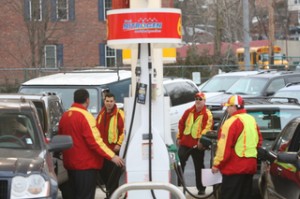Even as the demand for gasoline rises as the weather improves and the economy gets stronger, gasoline prices have remained flat for the past week even as the price of crude oil began to decline on markets all over the world.
The price of West Texas Intermediate crude oil reached a six-year low this past week, AAA noted, maintaining the downward pressure on the national price of gasoline, which has settled at $2.42.4 per gallon.
This downward pressure has, at least temporarily, offset potential price gains from the robust demand, regional refinery maintenance and the seasonal transition to more expensive summer-blend gasoline. Consumers are paying fractions of a penny less than one week ago, 14 cents more than one month ago and continue to save more than $1.10 in comparison to this same date last year. The national average has now fallen for 13 of the past 16 days.
Drivers on the West Coast continue to pay some of the nation’s highest averages for retail gasoline. Warmer temperatures in the region are credited with driving increased demand, and with ExxonMobil’s Los Angeles-area refinery and Tesoro’s Martinez refinery in the San Francisco Bay Area both running at reduced rates, supply has been unable to keep pace with growing demand. For the fourth consecutive week California at $3.27 remains the nation’s most expensive state for gasoline, followed by Hawaii at $3.15 and Alaska at $2.92.
(Low gas prices encourage near-record driving levels. For more, Click Here.)
Meanwhile, global crude prices continued to tumble with reports of growing supply and the strengthening U.S. dollar. The likelihood of a possible nuclear deal between the West and Iran also has the potential to bring more oil to the global market.
(Click Here for details about how collapse of oil prices rocked the auto industry.)
In addition, Saudi Arabia’s oil minister this week indicated that the Organization of the Petroleum Exporting Countries would not cut oil production to increase global oil prices, instead electing to let the market self-correct. The production in Saudi Arabia is at an all time high of nearly 10 million barrels per day as the Saudi continue to put pressure on the American producers of shale oil.
(To see more about gas prices falling after a brief jump, Click Here.)
The domestic oil market in the U.S is on the rise despite the oversupply as well as concerns that U.S. production could outpace storage capacity are contributing to even lower prices. West Texas Intermediate fell to its lowest level since the 2009 Great Recession this past week, although prices did recover some of those losses to end the week but oil futures were still trading at less than $50 per barrel.


Yup, the same old exploitation of consumers. When the wholesale price goes up the gas stations literally raise their prices hourly but when the wholesale prices drop it takes days before the prices are lowered if at all. It’s just a game of financial greed and consumer fraud.
Has anyone seen lower airfares or lower fuel surcharges from UPS/FEDEX since the price of fuel has dropped? How is it that these bogus fuel surcharges continue even after the substantial price drop for fuel?
With the price of crude dropping from 110$ to 40$ per barrel and the Bakken Shale producing a million barrels a day last year the oil companies were making 70 million dollars A DAY NET PROFIT! And they were have been fracking since 2004 in North Dakota. Wallstreet makes makes money off of main street and the mainstreet bails them out. T8me to turn the faucet off.
Locally, our gas prices have climbed to a dollar per gallon more than they were two months ago. Back in February, I paid $1.89 at a local Shell station, and yesterday, the Shell station sold 87 octane E-10 for $2.89.9. Incidentally, Diesel fuel at the same station was 20 cents cheaper(!) at $2.69.9.